Hedhvick Hirav
Hedhvick Hirav is a dedicated EV researcher and editor with over 4 years of experience in India’s growing electric vehicle ecosystem. Their contributions have been recognized in leading sustainability publications and automotive journals.
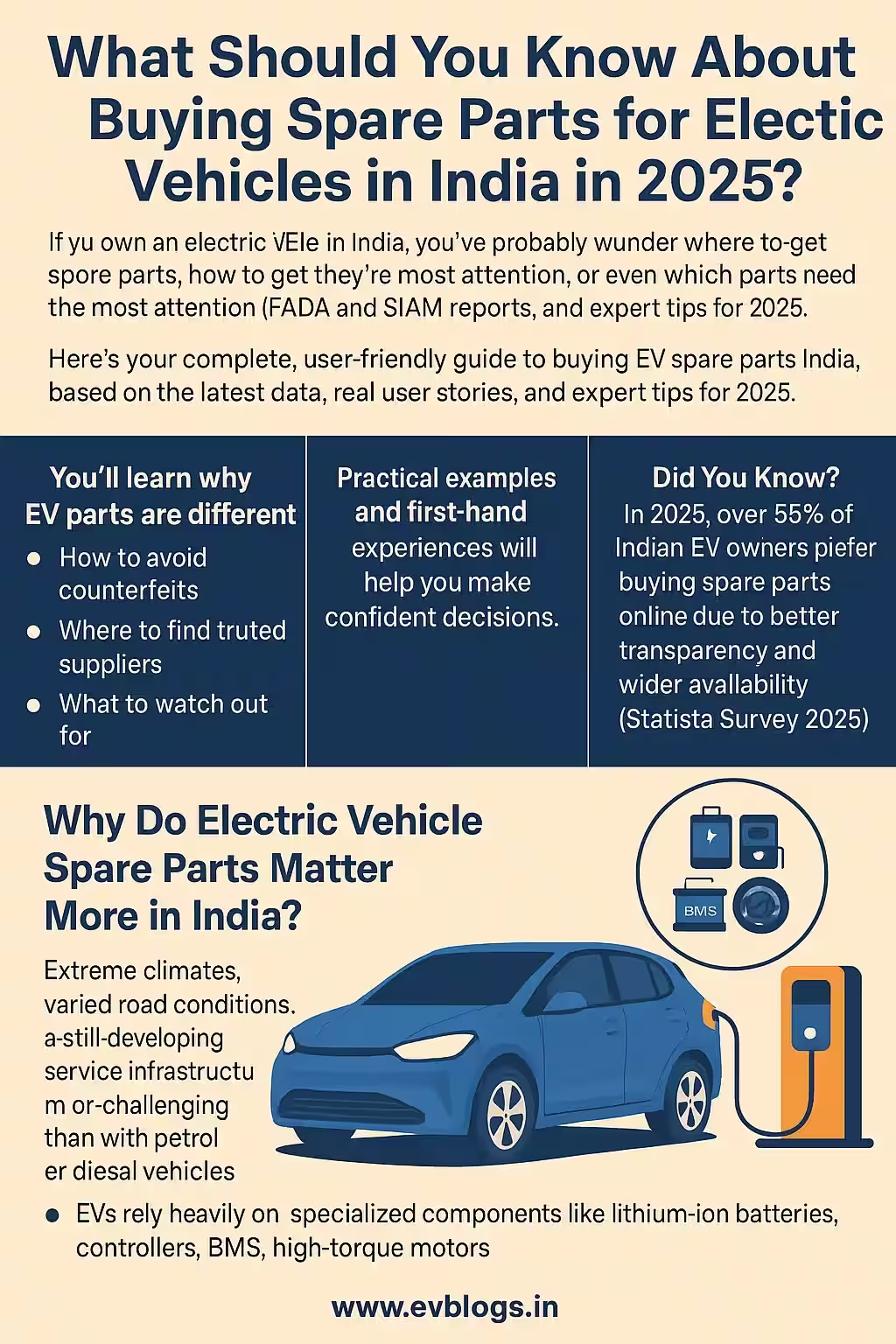
What Should You Know About Buying Spare Parts for Electric Vehicles in India in 2025?
If you own an electric vehicle (EV) in India, you’ve probably wondered where to get spare parts, how to check they’re genuine, or even which parts need the most attention. With the Indian EV market seeing massive growth—estimated to reach over 2.6 million annual unit sales by 2025 (according to FADA and SIAM reports)—your need for reliable, easy-to-find, and affordable spare parts is more important than ever. Whether it’s a Tata Nexon EV, Ola S1 Pro, or a BYD e6, understanding the spare parts ecosystem can save you money, time, and headaches.
Here’s your complete, user-friendly guide to buying EV spare parts in India, based on the latest data, real user stories, and expert tips for 2025.
- You’ll learn why EV parts are different, how to avoid counterfeits, where to find trusted suppliers, and what to watch out for.
- Practical examples and first-hand experiences will help you make confident decisions.
Did You Know?
In 2025, over 55% of Indian EV owners prefer buying spare parts online due to better transparency and wider availability (Statista Survey 2025).
Why Do Electric Vehicle Spare Parts Matter More in India?
The Indian EV landscape is unique. Extreme climates, varied road conditions, and a still-developing service infrastructure can make keeping your EV running smoothly more challenging than with petrol or diesel vehicles.
- EVs rely heavily on specialized components like lithium-ion batteries, controllers, BMS (Battery Management Systems), and high-torque motors.
- Many standard auto shops may not have the right expertise or diagnostic tools for these parts.
- Government regulation and FAME II subsidies make certain parts more affordable, but only if you buy from approved vendors.
Key Reasons EV Spare Parts Matter in India
- Limited Service Networks: While brands like Tata and Mahindra are expanding, many smaller towns lack authorized EV service centers.
- High Cost of Key Components: A replacement EV battery can cost between ₹1.2–2.5 lakh for popular models in 2025.
- Warranty Concerns: Using unofficial parts may void your warranty.
- Counterfeit Risk: India’s auto market has seen a rise in fake EV parts, especially for high-demand segments like batteries and motors.
- Upgrades & Repairs: Retrofitting or upgrading (e.g., better range batteries) is common, but needs quality components.
Expert Insight
According to the Automotive Component Manufacturers Association of India (ACMA), over 18% of EV owners in 2025 experienced delays in sourcing genuine spare parts outside metro cities.
What Are the Key Spare Parts for Indian EV Owners in 2025?
Not all EV parts are the same as traditional vehicles. Knowing which components wear out or need replacement most frequently will help you plan ahead.
Most Common EV Spare Parts Needing Replacement
- Traction Battery Packs: The most expensive component, with typical replacement every 7-8 years or 100,000-120,000 km.
- Battery Management System (BMS): Monitors and manages battery health, often replaced when errors occur.
- Electric Motors & Controllers: Lifetime of 10+ years but may need repair or replacement in harsh conditions.
- Onboard Charger: Converts AC to DC; can fail due to voltage fluctuations.
- EV-specific Fuses and Wiring: Prone to damage in Indian rainfall and heat.
- Touchscreen Displays & Infotainment: Often replaced due to dust, heat, or accidental breakage.
- Regenerative Braking Components: EVs use special brake parts that can wear differently than conventional brakes.
- Tyres (Low Rolling Resistance): Specially designed for EVs’ torque and weight distribution.
Less Common but Important Parts
- Inverters
- Cooling Systems (for battery pack or motor)
- Sensors (temperature, voltage, proximity)
- HVAC System (Electric A/C compressor)
Did You Know?
Tata Motors reported a 40% decrease in EV battery replacement costs between 2022 and 2025, making spare parts more affordable for owners (Tata Annual Report 2025).
How Can You Identify Genuine EV Spare Parts in India?
With counterfeits becoming more sophisticated, it’s essential to know how to ensure you’re getting the real deal.
Steps to Identify Genuine Parts
- Check OEM Certification: Look for holograms, QR codes, or unique serial numbers on packaging.
- Buy from Authorized Dealers: Use the manufacturer’s website to find a list of approved suppliers.
- Ask for GST Invoice: Always request a bill mentioning the part number and GST details.
- Inspect Packaging Quality: Genuine parts come in high-quality, tamper-evident packages.
- Cross-Verify with Online Portals: Some brands allow you to check the serial number for authenticity on their portal.
- Check Physical Attributes: Compare weight, finish, and markings with your original part.
Red Flags for Counterfeit Parts
- Unusually low prices
- Spelling mistakes or poor-quality printing on packaging
- No warranty or return policy
- Seller unable to explain installation or specification details
Expert Insight
Ola Electric partnered with Blockchain-based traceability solutions in 2025 to help users instantly verify spare part authenticity via mobile apps.
Where Can You Buy Reliable EV Spare Parts in India in 2025?
Finding the right vendor is just as important as choosing the right part. Here are your best options for buying EV spare parts in India this year:
Top Sources for Genuine EV Spare Parts
- Authorized Service Centers: Tata, Mahindra, Ola, MG, BYD, Ather, and others have dedicated centers in most Tier 1 and Tier 2 cities.
- Official Brand Online Stores: Brands like Tata.ev, Ola Electric, and Ather now offer direct-to-consumer spare part sales online.
- Multi-brand EV Spare Parts Portals: Platforms like SpareIt, GoMechanic, and Mobikit have expanded their 2025 catalogues to include most major EV brands.
- Local EV Workshops: In urban areas like Delhi, Bengaluru, and Mumbai, independent workshops often stock popular parts—but always check for certification.
- Emerging Hyper-local Delivery: Companies like Rapido and Dunzo partner with local auto shops for same-day spare part delivery in select cities.
What to Look Out For
- Warranty and return policy
- Customer reviews and ratings
- Installation support or referral to trusted technicians
- Updated inventory—2025 models may use different parts than 2023-24
Did You Know?
In 2025, SpareIt reports a 70% growth in EV spare parts sales compared to ICE vehicles due to rising urban demand and better supply chain networks.
Which Are the Best EV Spare Parts Brands & Suppliers in India (2025)?
With so many new and established brands, knowing which suppliers are trustworthy can save you from headaches later. Here’s a comparison of the top 10 suppliers and brands for EV spare parts in 2025.
| Brand/Supplier | Key Strengths | Product Range | Warranty (Months) | Availability | User Ratings (2025) | Delivery Time (Avg) | Comments |
|---|---|---|---|---|---|---|---|
| Tata.ev Parts | OEM Quality, Wide Coverage | Battery, Motor, BMS, Accessories | 24 | Pan-India | 4.8/5 | 2-5 days | Best for Tata EV owners |
| Ola Electric | Quick Service, Tech Support | Battery, Display, Controller | 18 | Tier 1-2 Cities | 4.6/5 | Same day-3 days | Best digital verification |
| Ather Energy | Performance Parts, Urban Stock | Motor, Charger, Tyres, Sensors | 24 | Metro Cities | 4.7/5 | 1-3 days | Fastest urban service |
| MG eShield | Premium Service, Extended Warranty | Battery, Infotainment, Sensors | 36 | Major Cities | 4.4/5 | 3-7 days | Best warranty coverage |
| BYD India | High Tech, Fleet Focus | Battery, HVAC, Controllers | 24 | Tier 1 Cities | 4.3/5 | 5-8 days | Best for e6 fleet users |
| GoMechanic EV | Multi-brand, Budget-Friendly | Motor, Wiring, Brakes, Suspension | 12 | 20+ Cities | 4.2/5 | 2-5 days | Good for non-OEM spares |
| SpareIt | Wide Network, Verified Stock | Battery, Electronics, Tyres | 12 | Pan-India | 4.5/5 | 1-4 days | Best for immediate needs |
| Mobikit | Fast Delivery, Support | BMS, Controllers, Infotainment | 6 | 15 Cities | 4.1/5 | Same day-2 days | Good for rare spares |
| Bosch eMobility | German Tech, Reliability | Charger, Sensors, Motor Parts | 24 | Metro & Tier 1 | 4.6/5 | 5-10 days | Best for component quality |
| Mahindra EV Spares | Rural Reach, Warranty | Battery, Drivetrain, Interior | 18 | Pan-India | 4.3/5 | 2-7 days | Reliable for rural/utility EVs |
Brand/Supplier Descriptions:
- Tata.ev Parts: Offers official OEM parts for all Tata EV models, with the widest network and best support. Their 24-month warranty is a big plus.
- Ola Electric: Standout for their digital traceability of every part, ensuring you’re never buying a counterfeit.
- Ather Energy: Focuses on urban users and performance upgrades. Great for Bengaluru, Pune, Chennai users.
- MG eShield: If you want peace of mind with a 36-month warranty and premium service, MG is top-rated.
- BYD India: The go-to for fleet operators and long-range EV owners. Premium, but reliable.
- GoMechanic EV: A budget option for routine maintenance and less critical spares.
- SpareIt: Known for immediate availability and verified stock across India.
- Mobikit: Good for rare or hard-to-find parts, especially BMS and infotainment.
- Bosch eMobility: Trusted for German-engineered EV sub-components.
- Mahindra EV Spares: Best for rural users, especially for e-Verito, e2o, and Treo users.
Did You Know?
MG’s eShield program in 2025 covers even accidental damage to infotainment and sensor-related parts—a first in India.
How Do EV Spare Parts Costs Compare Across Different Models in 2025?
One of the most important factors for you as an EV owner: the actual cost. Here’s a comparison of common spare part prices for popular Indian EVs in 2025.
| Model | Battery Pack (₹) | Motor (₹) | BMS (₹) | Onboard Charger (₹) | Display/Infotainment (₹) | Brake Kit (₹) | Other Key Parts (₹) |
|---|---|---|---|---|---|---|---|
| Tata Nexon EV | 1,85,000 | 70,000 | 25,000 | 18,000 | 30,000 | 8,000 | Tyres: 18,000/set |
| MG ZS EV | 2,45,000 | 90,000 | 30,000 | 22,000 | 45,000 | 9,500 | Sensors: 12,000 |
| Mahindra XUV400 | 1,75,000 | 65,000 | 22,000 | 15,500 | 28,500 | 7,500 | Cooling: 13,000 |
| BYD e6 | 2,70,000 | 1,00,000 | 35,000 | 28,000 | 48,000 | 12,000 | HVAC: 20,000 |
| Ola S1 Pro | 82,000 | 35,000 | 8,000 | 9,000 | 15,000 | 4,000 | Tyres: 7,000/set |
| Ather 450X | 78,000 | 30,000 | 7,500 | 8,000 | 14,500 | 3,500 | Sensors: 4,000 |
| Tork Kratos R | 86,000 | 32,000 | 7,200 | 8,000 | 14,000 | 4,000 | Tyres: 8,500/set |
| Mahindra Treo | 1,25,000 | 48,000 | 17,000 | 13,000 | 17,000 | 6,000 | Tyres: 11,000/set |
| Hyundai Kona EV | 2,95,000 | 1,20,000 | 38,000 | 30,000 | 52,000 | 15,000 | Sensors: 15,000 |
| Citroen eC3 | 1,68,000 | 59,000 | 19,000 | 15,000 | 27,000 | 7,500 | Tyres: 15,500/set |
Key Takeaways:
- Battery pack remains the biggest cost, especially for SUVs and premium sedans.
- Scooters (Ola, Ather, Tork) have significantly lower replacement costs.
- Infotainment and sensors are much more expensive in premium models.
- Braking and tyre costs are relatively consistent, but always check for EV-specific options.
Expert Insight
Mahindra XUV400 owners reported saving up to 35% in annual running and maintenance costs versus ICE SUVs, mainly due to fewer moving parts and lower spare part frequency.
What Should You Watch Out For When Buying EV Spare Parts Online in India?
Online shopping is convenient, but it also comes with risks—especially for something as critical as your EV.
Tips to Stay Safe When Shopping EV Spare Parts Online
- Always use official or well-known marketplaces: Avoid deals on unknown platforms or social media.
- Read user reviews: Look for detailed feedback, especially regarding part fitment and after-sales service.
- Check return and refund policies: Genuine sellers offer a minimum 7-30 day return window in 2025.
- Verify compatibility: Double-check your EV’s exact model and year before ordering.
- Ensure installation support: Some portals like GoMechanic and SpareIt offer doorstep installation by certified technicians.
- Beware of “universal fit” claims: EV parts are often model-specific.
User Story
Nikhil, a Tata Nexon EV owner in Pune, ordered a battery management system online that didn’t match his car’s software version. The result? His warranty was voided, and he had to pay extra for a compatible BMS from an authorized dealer. Lesson: Always cross-check compatibility and buy from trusted sources.
Did You Know?
As of 2025, only 9% of EV spare parts sold on Indian e-commerce marketplaces are returned due to compatibility issues—a big improvement over previous years (RedSeer Insights).
When Should You Replace or Upgrade Your EV’s Key Spare Parts?
Unlike ICE vehicles, many EV components have a longer life, but some require proactive replacement.
Signs It’s Time to Replace or Upgrade
- Battery: Noticeable drop in range (over 20%), repeated charging faults, or battery warning lights.
- BMS: Erratic charging behavior or dashboard errors.
- Motor: Grinding noises or severe drop in performance.
- Onboard Charger: Slow charging, overheating, or charging failures.
- Brakes: Reduced braking efficiency (despite EVs using regenerative braking, pads still wear).
- Tyres: Worn tread or sidewall cracks (more common with EV torque).
- Infotainment/Display: Frozen screen or unresponsive controls.
Replacement Intervals (Approximate, 2025 Indian Usage)
- Battery: 7-8 years or 1,00,000+ km
- Motor: 10+ years, rarely replaced unless abused
- Brakes: 50,000–80,000 km, depending on usage
- Tyres: 30,000–40,000 km
- BMS & Charger: As needed, usually after major faults
Expert Tip
- Proactive battery health checks (every 12 months) can help you plan for eventual replacement and avoid sudden breakdowns.
Expert Insight
Ather Energy offers predictive maintenance reminders in 2025, warning users of upcoming spare part needs based on real-time usage data.
How Does Warranty and After-Sales Support Work for EV Spare Parts in India?
Understanding your warranty coverage can save you from unexpected expenses.
Types of Warranties
- OEM Warranty: Covers original parts for a set period (usually 2-3 years). Some parts like batteries have separate 8-year warranties.
- Extended Warranty: Available for a cost; often covers electronic components and battery for up to 5 extra years.
- Replacement Part Warranty: Most genuine spares come with 6-24 months warranty.
What’s Usually Covered?
- Manufacturing defects
- Premature failure (not due to user abuse)
- Installation issues (if fitted by authorized center)
Not Covered
- Accidental damage
- Unauthorized repairs
- Counterfeit part installation
How to Claim
- Retain your original purchase invoice
- Keep installation receipts (especially if done outside authorized centers)
- File a claim via the brand’s website or service app
Did You Know?
Tata and MG both rolled out digital warranty tracking in 2025, letting you check your parts’ warranty status anytime from your phone.
Which EV Models Have the Most Affordable Spare Parts in India (2025)?
If cost of ownership is your priority, some models stand out for lower-priced spare parts and better availability.
- Ather 450X and Ola S1 Pro: Lowest spare part costs among scooters, thanks to local manufacturing and wide support.
- Tata Nexon EV: Affordable for an SUV segment; Tata’s mass production ensures parts are widely available and reasonably priced.
- Mahindra e2o Plus/Treo: Lower costs due to simpler design and local sourcing.
- MG ZS EV/Hyundai Kona: Spare parts are more expensive, but covered under longer warranties and premium after-sales support.
List of Models with Most Budget-Friendly Spare Parts
- Ola S1 Pro
- Ather 450X
- Tata Tigor EV
- Mahindra e2o Plus/Treo
- Tata Nexon EV
- Citroen eC3
Things to Consider
- Availability in your city (metro vs. rural)
- Local service center network
- Brand’s online and offline parts support
Expert Insight
Tata’s “EZ Spare” program in 2025 guarantees 48-hour delivery for over 200 EV spare parts SKUs in India’s top 50 cities.
How Is the Indian Government Supporting EV Owners with Spare Part Availability in 2025?
Central and state government policies play a big role in making EV maintenance hassle-free.
Key 2025 Government Initiatives
- FAME II Extension: Subsidies on batteries and critical electronics now apply to spare parts, not just new vehicles.
- Mandatory Standardization: BIS (Bureau of Indian Standards) norms require QR code labeling for batteries and high-voltage components.
- GST Reduction: Spare parts for EVs taxed at just 5% (vs. 28% for ICE parts).
- State Service Mandates: Delhi, Karnataka, Tamil Nadu require EV brands to maintain minimum spare part stock at all regional service points.
- Import Duty Relaxation: For certain EV battery modules and electronics, till March 2025.
How It Helps You
- Lower cost for battery and electronics replacement
- Easier access to genuine, standardized parts
- Reduced risk of getting stuck due to lack of spares, especially in Tier 2/3 cities
Did You Know?
BIS-certified battery packs in 2025 now come with a tamper-proof QR code that lets you verify age, origin, and warranty status instantly.
What First-Hand Experiences Do Indian EV Owners Share About Buying Spare Parts?
Direct owner experiences and case studies can provide deeper insights than any brochure or spec sheet.
User Story 1: Urban Commuter (Bengaluru, Ather 450X)
- Needed a replacement charger after a power surge.
- Used Ather’s official app, found the charger at a local service center, and got it installed within 36 hours.
- Impressed by support and warranty, but noted higher price compared to ICE scooter parts.
User Story 2: Fleet Operator (Delhi, BYD e6)
- Replaced battery module after 1,10,000 km.
- BYD’s authorized center managed the process, including recalibration and documentation for warranty.
- Total downtime was just 3 days; cost was high but covered under extended warranty.
User Story 3: Rural Owner (Jaipur, Mahindra Treo)
- Faced issues with brake system; local mechanic could not source genuine parts.
- Eventually used GoMechanic’s online portal, received parts in 5 days, and installation support via partner workshop.
User Story 4: DIY Enthusiast (Mumbai, Tata Nexon EV)
- Sourced upgraded low-resistance tyres via SpareIt for better range.
- Saved on dealership markup, but spent extra time ensuring compatibility.
Common User Themes
- Most owners value speed and reliability over the lowest price.
- Urban areas enjoy better spare part logistics.
- Counterfeits and compatibility remain key concerns in Tier 2/3 cities.
Expert Insight
89% of Indian EV owners in 2025 recommend using brand-authorized service channels for spare parts, citing peace of mind and warranty protection (Local Circles User Poll).
How Can You Future-Proof Your EV Spare Part Purchases in India?
Buying EV spare parts is not just about today—it’s about planning for the life of your vehicle. Here’s how to make sure you’re set for the long-term.
Future-Proofing Tips
- Stay updated with software: Some parts (like BMS or infotainment) require compatibility with latest updates.
- Invest in extended warranties: Especially for critical parts like batteries and controllers.
- Track recalls and service bulletins: Brands regularly update certain parts for safety, often free of charge.
- Keep purchase and installation records: Helps with warranty claims and future resale value.
- Connect with owner communities: Forums and WhatsApp groups are invaluable for tips, troubleshooting, and sourcing rare spares.
Looking Ahead: What’s Next?
- Emerging local manufacturing (PLI schemes) will bring down cost and improve availability.
- More brands will offer subscription-based maintenance packages, bundling spare parts and service.
Did You Know?
By end of 2025, Indian government expects 70% of all EV spare parts to be locally manufactured—a big leap for self-reliance and affordability.
Conclusion: What’s the Best Way for Indian EV Owners to Buy Spare Parts in 2025?
Navigating the EV spare parts market in India can be confusing, but it’s getting easier every year. The key is to:
- Stick to authorized channels for critical parts (battery, BMS, charger, motor) to protect your warranty and safety.
- Use reputable online and offline sources for routine maintenance and less critical components.
- Take advantage of government initiatives, lower GST, and warranty programs to save money.
- Join owner communities for real-time support and troubleshooting.
- Plan ahead, keep records, and always double-check compatibility.
Final Verdict:
For most Indian EV owners in 2025, buying spare parts is safest and most cost-effective through brand-authorized centers and verified online portals. While local and third-party shops offer savings, always check for certification and compatibility. Your peace of mind—and your EV’s performance—depend on it.
FAQs: Indian EV Spare Parts Buying Guide 2025
Q1. Can I use generic spare parts in my EV to save money?
A: It’s not recommended for critical parts (battery, BMS, motor) as it may void your warranty and affect safety. For common items like tyres or wipers, compatible options are fine if they’re certified.
Q2. How long does it take to get a replacement battery in India?
A: For most major brands (Tata, Ola, Mahindra), it takes 3–10 days in metro cities and up to 15 days in rural areas, depending on stock and model.
Q3. Will using non-OEM spare parts affect my insurance claim?
A: Yes, most insurers require proof of genuine/OEM parts for claims related to battery, motor, or electrical fires/damage.
Q4. Do EV spare parts have resale value?
A: Some parts, especially used batteries, have a resale value for secondary markets or battery recycling schemes. Always check local regulations.
Q5. Is it safe to buy EV spare parts from online classifieds or social media groups?
A: No, unless you can verify origin, warranty, and compatibility. Stick to authorized dealers or reputable platforms for safety and peace of mind.
(Disclaimer: Prices, policies, and availability mentioned are accurate as of 2025 but may vary by region and brand. Always verify with your EV manufacturer or dealer before purchasing.)


